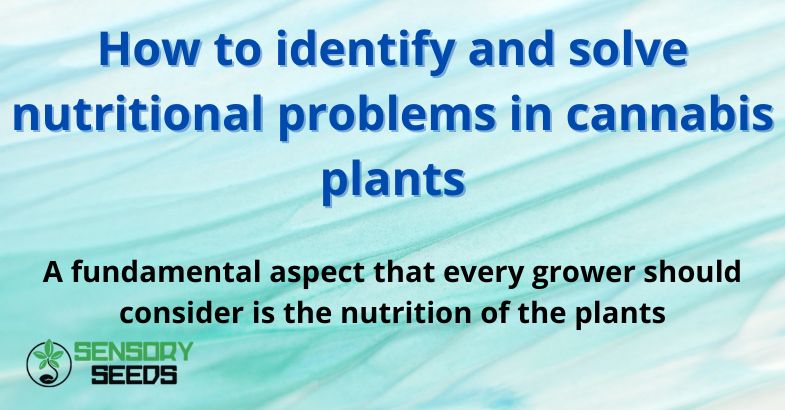Published on: 03/01/2025
A fundamental aspect that every grower should consider is the nutrition of the plants
A deficiency or excess of nutrients can compromise the health of cannabis plants and impact the quality and quantity of the harvest. Like all plants, cannabis requires a precise balance of macronutrients and micronutrients to grow strong and healthy.In this article, we will explore how to identify the most common nutritional problems in cannabis plants and how to solve them to ensure optimal growth.
The main nutrients for cannabis: an overview
Before diving into the specifics of nutritional problems, it’s important to understand which nutrients are essential for cannabis and how they impact plant growth. Generally, cannabis plants require three main macronutrients: nitrogen (N), phosphorus (P), and potassium (K), which are the pillars of healthy nutrition.
Each of these nutrients has a specific role:
- Nitrogen (N): Essential for vegetative growth, nitrogen is key in the formation of leaves and stems. Plants deficient in nitrogen will show clear signs of yellowing on the lower leaves.
- Phosphorus (P): Crucial for root development and energy production in plants, phosphorus also plays a role in the flowering process. A phosphorus deficiency can slow down growth and affect flower formation.
- Potassium (K): Vital for protein synthesis and disease resistance, potassium is important for flower development and overall plant health. A potassium deficiency shows up as brown edges on leaves and stunted growth.
In addition to these macronutrients, cannabis also requires a range of micronutrients, such as calcium, magnesium, sulfur, iron, manganese, copper, zinc, and molybdenum. While needed in smaller amounts, these micronutrients are equally important for the overall health of the plant.
Read also : Essential Ventilation Tips for Thriving Indoor Cannabis Plants


Signs of nutritional problems: how to recognize them
Recognizing the signs of nutrient deficiencies or excesses is crucial for timely intervention and preventing the problem from affecting the plant’s growth. Each nutrient has distinctive symptoms that indicate an issue. Here, we will explore the most common signs of nutrient deficiencies and excesses in cannabis plants.
Nitrogen deficiency
Nitrogen deficiency is one of the most common nutritional problems in cannabis plants, especially during the vegetative phase. The older, lower leaves of the plant begin to yellow and wither, while the overall growth of the plant slows down. If the deficiency is severe, the yellowing extends to the upper leaves as well. Nitrogen is a key nutrient for photosynthesis and cell growth, so its lack impairs the normal development of the plant.
Phosphorus deficiency
Phosphorus deficiency can manifest as darkened leaves or a bluish-purple tint, especially in the older leaves. In some cases, brown or necrotic spots may appear, indicating a reduction in the plant’s energy flow. Phosphorus deficiency slows root growth and can severely impact flowering. Plants with phosphorus deficiencies are also more susceptible to diseases and environmental stress.
Potassium deficiency
Potassium deficiency presents with brown or scorched edges on the leaves, followed by general wilting. Affected plants may also show stunted growth, with weak stems unable to support the weight of the flowers. Potassium is essential for protein synthesis and disease resistance, so its deficiency can reduce the quality of the harvest.
Calcium deficiency
Calcium is essential for the health of plant cells, particularly for the formation of cell walls. Calcium deficiency manifests as distorted growth, especially at the tips of the shoots. Young leaves may appear curled, deformed, or necrotic. In severe cases, calcium deficiency can impair root formation and the plant’s ability to absorb other nutrients.
Magnesium deficiency
Magnesium is a key component of chlorophyll, so a deficiency results in yellowing of the leaves, starting from the edges and progressing towards the center. The leaves may also show red or purple streaks, especially when other deficiencies, like phosphorus, are present. Magnesium deficiency hinders photosynthesis, slowing down the overall growth of the plant.
Excess nutrients
Although deficiencies are a common issue, an excess of nutrients can also cause serious damage to cannabis plants. For example, an excess of nitrogen can lead to excessive leaf and stem growth, but the plant becomes weak and susceptible to diseases. An excess of potassium can reduce the plant’s ability to absorb other essential nutrients, while an excess of phosphorus can cause a blockage in the flow of other nutrients, such as iron and magnesium, leading to secondary deficiencies.
Read also : Indoor cannabis seeds: strengths and weaknesses of these seeds
Solving cannabis `plant nutrition problems
Once the nutritional problem is identified, it is essential to intervene promptly to correct it. Here are some guidelines on how to resolve the most common nutritional issues.


How to fix nitrogen deficiency
If the plant shows signs of nitrogen deficiency, the first step is to apply a nitrogen-rich fertilizer. You can choose either a liquid fertilizer or a slow-release one, depending on your preferences and the plant’s needs. Make sure not to overdo it, as too much nitrogen can cause other issues. Additionally, try to maintain a good balance between nitrogen, phosphorus, and potassium, as excess nitrogen can interfere with the absorption of these other nutrients.
How to fix phosphorus deficiency
Phosphorus deficiency can be corrected by applying phosphorus-rich fertilizers, often in the form of superphosphate. Alternatively, you can use organic amendments like bat guano, which is naturally high in phosphorus. If the deficiency is severe, it may also be helpful to improve the soil structure to facilitate the absorption of this nutrient.
How to fix potassium deficiency
To correct potassium deficiency, you can use fertilizers high in potassium. These are typically available in liquid or granular formulations and can be applied during critical growth stages, such as flowering. It is also important to monitor the soil’s pH balance, as a pH that is too low can limit potassium absorption.
How to fix calcium and magnesium deficiency
To correct calcium deficiency, you can apply calcium in the form of hydrated lime or calcium nitrate. Similarly, for magnesium, using magnesium sulfate (Epsom salt) can quickly address the issue. These two nutrients work synergistically, so it’s important to apply them together when symptoms are evident.
How to prevent nutritional problems
Prevention is always key to successful cultivation. Using a good balanced fertilizer, regularly monitoring nutrient levels, and maintaining the soil pH within the ideal range for cannabis (between 6.0 and 7.0) are essential steps to avoid nutritional problems. Additionally, it is crucial to regularly observe the plants for signs of stress, so that you can intervene before the problems become severe.
Conclusions
Identifying and solving nutritional problems in cannabis plants is an essential part of cultivation. With a good understanding of the necessary nutrients and the signs of deficiencies or excesses, growers can ensure their plants have a healthy and thriving growth environment. Careful and timely attention not only prevents long-term damage but also enhances the quality of the harvest, contributing to a successful cultivation. With the right approach and solutions, any grower can get the most out of their cannabis plants, whether for medicinal or recreational purposes.









